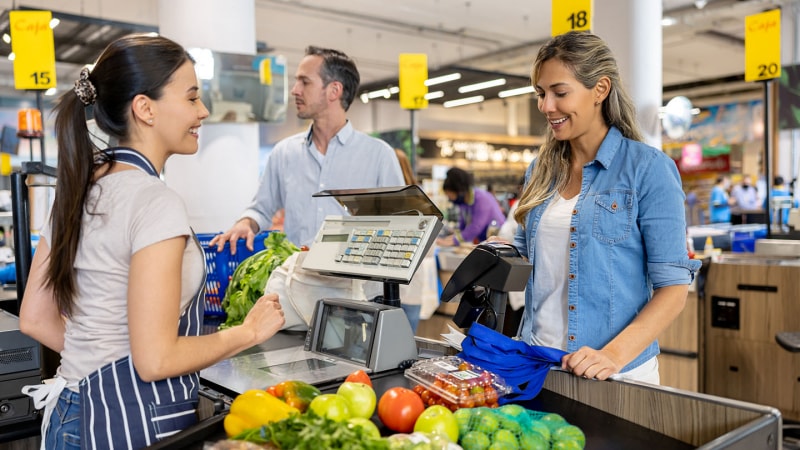Guide to maximizing rewards on grocery store purchases

Quick insights
- You may find that putting grocery store purchases on a rewards credit card can help you earn points.
- Some credit cards offer higher rewards and more cash back on grocery store purchases.
- Not all stores that sell groceries will be classified as grocery stores for a card’s spending categories.
The cost of groceries has risen since the COVID-19 pandemic. With people spending more on groceries than they have in years past, earning credit card rewards for grocery store purchases may take some of the sting out of those higher bills. In this article, we’ll discuss putting groceries on a credit card and how you may be able to earn rewards when you swipe your card at the grocery store.
Using a credit card at the grocery store
Whether you're making your weekly grocery run or picking up a few things at the corner store, there may be good reason to use your credit card at check out. Some credit cards offer higher cash back rewards or discounts on eligible grocery store purchases.
Points can be offered at a standard earn rate by the card or they can be part of a rotating category of expenses that earns rewards on a limited basis. Bear in mind that quarterly bonus categories may require activation. Some cards may also provide additional perks for grocery store purchases such as discounts, free delivery, special promotions or higher rewards for using specific grocery delivery services.
That doesn’t mean that every store that sells groceries will be included with your card’s grocery store spending category. There may be exceptions for certain retailers. If you’re uncertain if a store qualifies, you may want to make a smaller purchase to test the rewards you earn or contact your card’s customer service number to see if your grocery store qualifies.
Earning cash back rewards on grocery stores
Many credit cards offer cash back rewards on grocery store purchases. Cash back rewards are a type of credit card reward where a percentage of the purchase amount is returned to the cardmember as rewards. For example, if a credit card offers 2% cash back on grocery stores and you spend $100 on groceries, you would earn $2 in cash back rewards points.
Some credit cards may have spending limits or restrictions on the amount of cash back you can earn on grocery store purchases. For example, the Chase Freedom Flex® card earns 5 points per dollar on rotating bonus categories (that can include grocery stores) with a $1,500 quarterly spending cap. Any purchase you make over the limit will earn the standard rewards rate.
Using a credit card shopping portal to buy groceries
Credit card shopping portals are online platforms that allow cardmembers to earn additional rewards or discounts when making purchases through affiliated retailers. These portals can include grocery stores as participating merchants. Some credit card issuers have their own shopping portals, while others partner with third-party platforms.
To maximize rewards, you may want to compare offers across different shopping portals, check for any special promotions or limited time offers. It can be helpful to ensure that you are logged in to your credit card account before making a purchase through the portal.
Choosing the best cash back credit cards for grocery store purchases
When considering the best cash back credit card for you, you may want to think about the following:
- Compare cash back percentages, annual fees and other features of various credit cards to determine which ones offer rewards that align best with your spending habits.
- Consider factors such as preferred redemption options and any additional benefits or perks offered by the cards.
- Look for credit cards that offer higher cash back percentages specifically for grocery store purchases.
- Review for features like welcome bonus offers, introductory APR offers and additional benefits like extended warranties or travel insurance.
Also, you may want to consider any fees associated with the card. If the card has an annual fee, consider if the potential rewards earned outweigh the cost.
In summary
Using your credit card to buy groceries may earn you higher cash back or rewards. However, not all stores that sell groceries will be classified as grocery stores. Before determining if you should use your credit card to purchase groceries, it can be helpful to understand how the card's rewards structure works. In addition, it may be helpful to fully read your card's terms and conditions.



